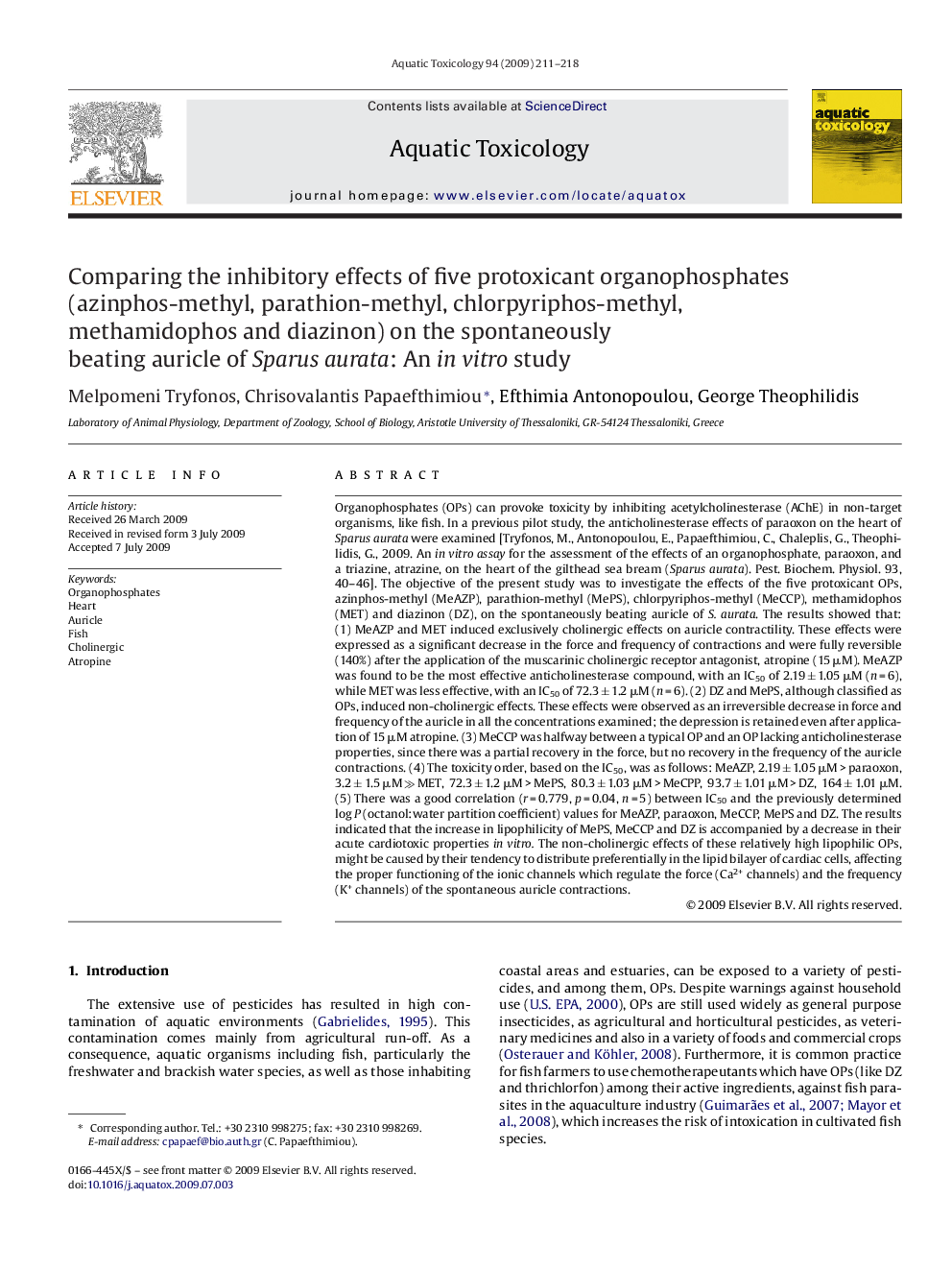| کد مقاله | کد نشریه | سال انتشار | مقاله انگلیسی | نسخه تمام متن |
|---|---|---|---|---|
| 4530461 | 1324705 | 2009 | 8 صفحه PDF | دانلود رایگان |

Organophosphates (OPs) can provoke toxicity by inhibiting acetylcholinesterase (AChE) in non-target organisms, like fish. In a previous pilot study, the anticholinesterase effects of paraoxon on the heart of Sparus aurata were examined [Tryfonos, M., Antonopoulou, E., Papaefthimiou, C., Chaleplis, G., Theophilidis, G., 2009. An in vitro assay for the assessment of the effects of an organophosphate, paraoxon, and a triazine, atrazine, on the heart of the gilthead sea bream (Sparus aurata). Pest. Biochem. Physiol. 93, 40–46]. The objective of the present study was to investigate the effects of the five protoxicant OPs, azinphos-methyl (MeAZP), parathion-methyl (MePS), chlorpyriphos-methyl (MeCCP), methamidophos (MET) and diazinon (DZ), on the spontaneously beating auricle of S. aurata. The results showed that: (1) MeAZP and MET induced exclusively cholinergic effects on auricle contractility. These effects were expressed as a significant decrease in the force and frequency of contractions and were fully reversible (140%) after the application of the muscarinic cholinergic receptor antagonist, atropine (15 μM). MeAZP was found to be the most effective anticholinesterase compound, with an IC50 of 2.19 ± 1.05 μM (n = 6), while MET was less effective, with an IC50 of 72.3 ± 1.2 μM (n = 6). (2) DZ and MePS, although classified as OPs, induced non-cholinergic effects. These effects were observed as an irreversible decrease in force and frequency of the auricle in all the concentrations examined; the depression is retained even after application of 15 μM atropine. (3) MeCCP was halfway between a typical OP and an OP lacking anticholinesterase properties, since there was a partial recovery in the force, but no recovery in the frequency of the auricle contractions. (4) The toxicity order, based on the IC50, was as follows: MeAZP, 2.19 ± 1.05 μM > paraoxon, 3.2 ± 1.5 μM ≫ MET, 72.3 ± 1.2 μM > MePS, 80.3 ± 1.03 μM > MeCPP, 93.7 ± 1.01 μM > DZ, 164 ± 1.01 μM. (5) There was a good correlation (r = 0.779, p = 0.04, n = 5) between IC50 and the previously determined log P (octanol:water partition coefficient) values for MeAZP, paraoxon, MeCCP, MePS and DZ. The results indicated that the increase in lipophilicity of MePS, MeCCP and DZ is accompanied by a decrease in their acute cardiotoxic properties in vitro. The non-cholinergic effects of these relatively high lipophilic OPs, might be caused by their tendency to distribute preferentially in the lipid bilayer of cardiac cells, affecting the proper functioning of the ionic channels which regulate the force (Ca2+ channels) and the frequency (K+ channels) of the spontaneous auricle contractions.
Journal: Aquatic Toxicology - Volume 94, Issue 3, 14 September 2009, Pages 211–218